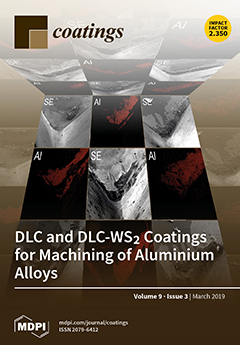In this study, the synergistic effects of NH
4HF
2, sodium phytate (Na
12Phy), K
2ZrF
6, and treatment time on corrosion resistance of a micro-arc oxidation (MAO) treated magnesium alloy and the entrance mechanism of P, F,
[...] Read more.
In this study, the synergistic effects of NH
4HF
2, sodium phytate (Na
12Phy), K
2ZrF
6, and treatment time on corrosion resistance of a micro-arc oxidation (MAO) treated magnesium alloy and the entrance mechanism of P, F, and Zr into anodic coatings were investigated using an orthogonal method. In addition, the roles of NH
4HF
2, Na
12Phy, and K
2ZrF
6 on coating development were separately studied. The results show that NH
4HF
2 and Na
12Phy, the corrosion inhibitors of magnesium alloys, are beneficial but K
2ZrF
6 is harmful to developing anodic coatings. The corrosion resistance of MAO coatings is synergistically determined by coating characteristics, though the coating thickness plays a main role. Na
12Phy significantly improves but NH
4HF
2 decreases the corrosion resistance of MAO coatings, while excess high K
2ZrF
6 is harmful to the coating corrosion resistance. Treatment time can increase the coating thickness but is the least important factor in corrosion resistance. During MAO, NH
4HF
2, Na
12Phy, and K
2ZrF
6 take part in coating formation, causing P, F, and Zr to compete with each other to enter into anodic coatings.
Full article





